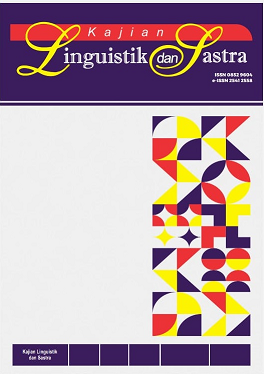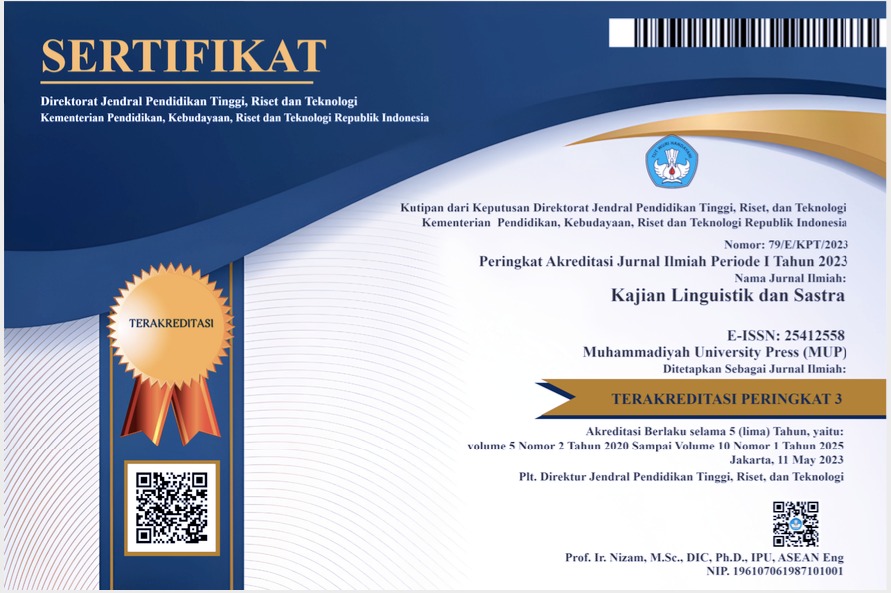Pronomina Persona dalam Bahasa Modole: Kajian Morfosintaksis
Abstract
The Modole language, abbreviated (BM), is part of the West Papua language phylum spoken by the
Modole Tribe in Kao District, North Halmahera Regency, North Maluku Province. This study aims to
describe the form and characteristics of personal pronouns in BM. In addition, this study is a form of
documentation as an effort to preserve, protect, and develop BM. This study is descriptive qualitative
with a morphosyntactic approach. The data in this study are direct speech in the form of words, phrases,
clauses, and sentences using morphological questionnaires and syntactic questionnaires. The data
collection method uses the listening method with the note and record technique, and the conversation
method with the fishing technique. The data analysis method of this study uses the name and naming
model analysis method to analyze the form of pronouns in BM, which has a major influence on changes
in the form of verbs, including the process of the emergence of proclitics in the verbs. The results of the
study indicate that the second singular personal pronoun in BM recognizes gender differences, and the
form of the BM personal pronoun can change the verb construction by producing proclitics in the verbs.
In addition, verb constructions are found in all forms of BM pronouns.
Downloads
References
[1] C. L. Voorhoeve, “Contact-Induced Change in the Non-Austronesian Languages in the
North Moluccas, Indonesia,” in Language Contact and Change in the Austronesian World,
1994. doi: doi: 10.1515/9783110883091.649.
[2] S. O. Mulae and D. Sarif, “Kekerabatan Bahasa Non-Austronesia di Halmahera Barat
(Bahasa Sahu, Waioli, Gamkonora, Ibo, Tobaru, Loloda) Bahasa Ternate dan Bahasa
Tidore,” J. Penelit. Hum., vol. 12, no. 2, pp. 48–55, 2021, [Online]. Available:
https://ejournal.unkhair.ac.id/index.php/humano/article/view/3281/2434
[3] A. Alexander and R. Kikusawa, “Malagasy Personal Pronouns: A Lexical History,” Ocean.
Linguist., vol. 53, no. 2, pp. 480–516, 2014, doi: doi: 10.1353/ol.2014.0020.
[4] T. Li, “The Personal Pronoun in Christian Palestinian Aramaic,” JAOS, vol. 139, no. 1, pp.
165–182, 2021, doi: https://doi.org/10.7817/jameroriesoci.139.1.0165.
[5] Liljana Mitkovska and E. Bužarovska, “Subject Pronoun (non)Realization in the English
Learner Language of Macedonian Speakers,” Second Lang. Res., vol. 34, no. 4, pp. 463–
485, 2018, doi: doi: 10.1177/0267658317747925.
[6] M. E. D. Lering, “Infleksi Verba Bahasa Sikka Etnis Krowe Pada Penggunaan Pronomina,”
Diglossia, vol. 12, no. 2, pp. 80–88, 2021, [Online]. Available:
https://journal.unipdu.ac.id/index.php/diglosia/article/view/2037
[7] O. Shelty, Y. Puspita, and H. Nufus, “Analisis Kontrastif Pronomina Bahasa Musi dengan
Bahasa Indonesia,” Parataksis J. Bahasa, Sastra, dan Pembelajaran Bhs. Indones., vol. 6,
no. 1, pp. 1–12, 2023, doi: 10.31851/parataksis.v6i1.12571.
[8] E. Duwita and N. Jalaludin, “Pemarkah Persona Bahasa Gebe Halmahera Tengah,”
Tekstual, vol. 20, no. 2, p. 116, 2022, doi: doi: 10.33387/tekstual.v20i2.5570.
[9] E. Duwila and N. Nurfani, “Penanda Kata Ganti Orang dalam Bahasa Ternate,” Gramatika
J. Ilm. Kebahasaan dan Kesastraan, vol. 7, no. 1, pp. 71–79, 2019, doi:
10.31813/gramatika/7.1.2019.181.71--79.
[10] S. Boonman, “Word-Internal ‘Thorn’ Clusters and The Dative Singular of the PIE 1st Person
Pronoun,” Hist. Linguist., pp. 43–74, 2022.
[11] A. Abbas, Morfosintaksis Bahasa Makassar. Malang: Rena Cipta Mandiri, 2021.
[12] J. Garing, “Pertalian Kekerabatan Bahasa-Bahasa Toraja, Bugis, dan Makassar: Kajian
Morfosintaksis,” Metalingua, vol. 14, no. 1, p. 71—82, 2016.
[13] I. W. Simpen, Morfologi: Kajian Proses Pembentukan Kata. Jakarta: Bumi Aksara, 2020.
[14] M. Khairah and S. Ridwan, Sintaksis: Memahami Satuan Kalimat Perspektif Fungsi. Jakarta:
Bhumi Aksara, 2022.
[15] B. P. dan P. Bahasa, Tata Bahasa Baku Bahasa Indonesia Edisi Keempat. Jakarta, 2017.
[16] Y. Abidin, Konsep Dasar Bahasa Indonesia. Jakarta: Bhumi Aksara, 2019.
[17] B. K. Purwo, “Pronomina di dalam Bahasa Indonesia,” J. Linguist. Indones., vol. 4, no. 7, pp.
17–39, 1986.
[18] P. Baryadi, Morfologi dalam Ilmu Bahasa. Yogyakarta: Sanata Dharma University Press,
2022.
[19] Y. Sanjoko, “Morfosintaksis Verba Bahasa Skou,” Widyaparwa, no. 44, pp. 10–20, 2016.
[20] M. Taha, “Proklitik Pronomina Persona Bahasa Taba,” Gramatika J. Ilm. Kebahasaan dan
Kesastraan, vol. VII, Nomor, pp. 42--49, 2019.
[21] A. N. Rachmawati and T. Hariri, “Pronomina Persona Bahasa Sunda,” JIIP - J. Ilm. Ilmu
Pendidik., vol. 6, no. 2, pp. 947–951, 2023, doi: DOI:10.54371/jiip.v6i2.1286.
[22] P. Ruriana, “Pronomina Persona dan Bentuk-Bentuk Lain Pengganti Pronomina Persona
dalam Bahasa Blambangan (Personal Pronoun and Other Forms of Personal Pronoun),”
Metalingua, vol. 16, no. 2, pp. 231–246, 2018.
[23] R. Muhidin, “Pronomina Bahasa Komering,” Kibas Cenderawasih J. Bhs. dan Kesusastraan,
vol. 17, no. 1, pp. 33–45, 2020, doi: https://doi.org/10.26499/kc.v17i1.261.










